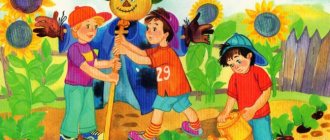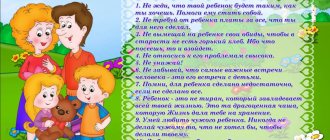Dump truck
For this competition, you will need to provide each participant with a dump truck (you can buy identical small cars in a children's toy store). Near each participant there will be an identical pile of candies, for example. Each participant, at the command “start,” puts one candy in the back and carries it in the car along the floor to his mark (on the same line for everyone). Then he unloads the candy and goes for the next one. The first participant to transport all the candies on a dump truck will win and receive a prize.
Catch the bird
For this competition, masks of migratory birds or headdresses with images of such birds are first prepared. The presenter invites approximately 8-10 children. One is appointed as driver. The driver's task is to catch birds returning from wintering grounds, blindfolded. At the same time, children can tease the driver, trying to imitate the bird he got with his voice. Ducks, larks, swallows, cuckoos, starlings, herons, etc. usually return from wintering in the spring. The competition is guaranteed to be fun, since even if the child knows what sounds this or that bird makes, it will not be easy to reproduce them.
What do toys need?
All children love toys. A fun and exciting competition with your favorite friends. Each participant has the same row of toys in front of them, for example, a baby doll, a bear, a bunny, a car without a wheel, and so on. In general, everything that can be selected from the assortment of your own and borrowed toys. The point is that for each toy there will be an addition or a missing element, for example, for a baby doll - a pacifier, for a bear - a barrel of honey (a jar with the word “HONEY” written on it), for a bunny a carrot, for a car a wheel, and so on. So, the toys are in front of the participants, and on the command “start” the children each receive a bag with missing or complementary elements and distribute these parts among the toys. Whoever distributes everything faster and correctly will win.
Smeshariki
Each participant receives an album sheet on which the same picture is drawn, namely all Smeshariki (Krosh, Nyusha, Hedgehog, Losyash, Sovunya, Kar Karych, Pin, Pandi). But, near each Smesharik there is a missing place where some item is missing. All children know Smeshariki and, with the help of their imagination and knowledge about these heroes, will remember and come up with what needs to be completed. So, at the “start” command, the children pick up a felt-tip pen and begin to draw one object for each Smesharik, for example, for Krosha - a carrot, for Hedgehog - glasses, for Pandi - a bow, for Sovunya - a ladle, and so on. The participant who is the first to complete the task and complete the drawings for everyone on the subject will be the winner. A prize can also be awarded to the most creative participant who will complete the drawing of the most “interesting” objects for the Smeshariki.
Apchhi
Everyone can participate in turn. The first person to come is invited and is blindfolded. Then the host points his finger at any guest, and he must imitate “apchhi” - sneeze. And the participant with his eyes closed must recognize the sneezing person by this sound and say his name, then the host points his finger at the other guest, he sneezes, the participant guesses, and so on 3 more times. The number of sneezes the participant can guess is how many points he will receive. Then the next participant is invited to participate. For him, too, 5 different guys take turns sneezing. And the participant guesses them by the sound “apchhi”. And in the end, the participant with the most points will be the winner.
Accuracy test
Children are divided into teams with the same number of people. For each team, a row of 5 wide-necked jars is located at the same distance. Each team lines up in a separate row, each participant is given a small ball (bouncer). At the command “start”, starting with the first participants, the guys throw their ball, trying to get into the jar. He threw, and regardless of whether he hit or not, stand at the end of the team, the second participant’s turn is to throw, then the third, and so on. Only if you miss the mark, the presenter picks up the ball and hands it back to the participant. When the last participant has made the throw, and each jar still does not contain one ball, the first participant throws again, then the second. Participants take turns throwing throws until one of the teams fills all the jars, namely, throws a ball into each jar, that is, a prerequisite: there must be a ball in each jar. The team that manages to fulfill this condition first will be the winner.
Competitions for children for the holiday
Nowadays, you simply cannot limit yourself to a magnificent feast for a holiday where children are present! Whatever holiday it is - birthday, New Year or any other - there must be a fun part. In this article we will tell you the most interesting and fun games for children of any age. It would be more interesting to make a themed holiday, for example, a parent or any other adult could wear a fancy dress as the host of competitions. Children will become interested and easily enter the game. It will be fun, join us!
Competitions for children of any age
"Let's get acquainted"
The children and the leader stand in a circle, the teacher holds the ball, then he says his name and the name of the person to whom he throws the ball. The named child must catch the ball, say his name and the name of the person to whom he will throw the ball, etc.
This game helps children get to know each other and also engage shy children in communication.
"Children of Color"
This competition is also held at the very beginning of the holiday, so that the children can get to know each other a little. The presenter seats all the guys at the table, and then invites everyone who is wearing blue to stand. Those who rise in turn must say their name and explain who they are related to the birthday person. Then the leader calls the next color, etc. Make sure that each child is involved.
"Who am I?"
This game can be played anywhere, you will need two or more children. It does not require any preparation, you just need a little imagination and imagination.
The presenter asks the players “Who am I?” and depicts (with gestures, facial expressions, sounds, etc.) a train, a car, a teapot, an airplane, a salesman, a doctor, a dog, a cat, etc. Then the roles change: the child who solved the riddle becomes the leader.
Naturally, the possibilities for such a display are almost limitless and depend only on the age and life experience of the children taking part in the game.
This game with various options and complications will not get boring even at an older age.
"Who am I? With pictures"
This is another version of the “Who Am I” game, but the task becomes more complicated, now the player does not choose who to portray, now this choice belongs to the card drawn by the player. Cut out pictures of animals and objects from a magazine and paste them onto cardboard cards, creating a kind of card deck.
Each player takes turns drawing a card from the deck.
If the child draws a picture of a cat, he must pretend to be a cat (other options: crocodile, snake, elephant, bird, flower, train, etc.)
This is a great game for developing imagination, speech and communication skills.
"What happens"
This game requires a piece of paper and pencils for each player. The first player begins a drawing (you can only draw one line). The next player says that this may be and draws another line. The next one must come up with something else and complete the line in accordance with his plan. This continues until one of the players can no longer change the drawing in his own way. The person who made the last change wins.
"Bagel"
The presenter explains to the kids that to any question that is asked now, everyone should answer only one word - bagel. The presenter’s task is to prepare as many children’s questions as possible in advance and ask them quickly. And the kids need to listen carefully and not get confused with the answer. Well, not every kid responds to the question: “What’s your name?” will quickly answer about the bagel. It turns out to be a lot of fun if the questions are interesting. The main word, of course, can be changed!
"Teremok"
This activity will require a large blanket and 3 adult helpers. Two of them will hold the blanket at a height of about 1 m - this is the roof of the tower. All the children are little animals that have already climbed into the house and are waiting for the bear to come. Then a grandfather or father appears, it’s great if he’s in a bear outfit or at least a mask. He slowly approaches the tower and, after a fabulous dialogue that all kids know, pretends that he wants to climb onto the roof. The children run away screaming. And then, most often, they ask you to repeat this moment 7-10 times.
"Ear, Nose, Throat"
For this game you need to choose a leader, it is better if at first it is one of the adults, then the children will take a closer look, understand the rules of the game and will be able to drive themselves. The principle is this: the presenter touches the nose or eye, naming them. And all participants must do the same. But the role of the presenter is to confuse the participants, therefore, after some time, naming the nose, he touches his chin or forehead, and the participants, carried away by his example, do the same. The one who repeats the leader’s incorrect gesture is eliminated from the game. The most attentive and dexterous one wins.
"Lost Color"
All the children stand in a circle, and the leader explains that when he says: “One, two, three, find the red color!” - the guys must find this color on the guests or in the hall and put their palm to it. The one who could not find anything sits down, and for the rest the competition continues. Now the presenter calls a different color. And so on until one participant remains.
"Our favorite loaf"
And how can we do without the favorite children’s competition “Loaf”, when all the children stand in a circle, and the birthday boy is in the center of it and begin to sing: “Like on Sasha’s name day...”. This is a very kind and emotional competition, in which children's first sympathies and the openness of their souls are revealed. The one chosen by the birthday boy, in turn, stands in a circle and the song is sung again.
"Catch-up"
Young children are restless people, so encourage them to stretch. For this competition you need to form a circle, the children must firmly hold hands. In the center of the circle is the birthday boy Vanya. And the presenter announces that Baba Yaga has just called him and promised a big reward for the birthday boy. So now the presenter will catch Vanya and drag him away. Cheerful music is playing. Children should raise their hands to let running Ivan pass, but firmly block the road when the leader approaches them. There will be plenty of squeals and joy.
"Blow the Balloon"
An inflated balloon is placed on the edge of the table. The driver is blindfolded and placed with his back to the table. Then he takes 5 steps forward and turns in place three times. Next, he must return to the table and blow the ball onto the floor. Most likely, he will lose the right direction and will blow the ball away from where there is no trace of it. It will be very funny!…
"Ropes"
Prepare bright long ropes in advance, tie empty plastic bottles around the edges, and make a knot with the latter. Invite couples to the competition. At the leader’s signal, the children begin to twist the string onto the bottle. Whoever gets to the knot first is the winner. You can complicate the competition by using smooth satin ribbons.
"Broken phone"
The more a person plays “damaged phone”, the more fun the game is. It consists of the following: the first player whispers a word into the neighbor’s ear, he, in turn, whispers to the neighbor what he heard, the next one passes on the word, etc. Usually the word transmitted at the beginning is very different from the word heard by the last player.
"Fanta"
The presenter collects some items from all family members - forfeits. Then one of those present turns his back to the presenter. The presenter pulls out the items one by one and says: “What is this little wrapper bow to do?” The one who turns away does not see this phantom and makes a wish: for example, to jump five times on one leg, sing a song, dance or recite a poem, you can kiss someone, etc. One of these wishes will have to be made by the person making the wish himself.
"5 Things"
The child is asked to name 5 objects of a given shape or color in one minute. For example - 5 round (square, triangular) objects or 5 red (blue, green, yellow) objects. The difficulty of the task depends on the age of the participants. The one who did not manage to name the objects in the allotted time is eliminated from the game. Repetitions don't count!
"Box in a box"
Take a small box and place a toy or other prize in it. Place this box in a larger box, and put the larger box in one that is even larger. The more boxes, the more interesting it is to play.
Children sit in a circle and pass the box to each other, while music plays. When the music has stopped, the one who has the magic box in his hands opens one of them - the first one. The lucky player who opened the last prize box takes the prize for himself.
"Clothespins"
Any number of children can participate. The driver asks all participants to turn away and count to 30, and at this time attaches clothespins to household items - a chandelier, paintings, curtains, soft toys, dishes (20-30 pieces in total). The one who managed to collect the most clothespins receives a prize and becomes the driver.
"Titanic"
Pour water into the bucket (no more than half). Give each child a disposable cup. There will also be a plastic cup in the role of the Titanic. Pour some water into it (it should float) and place it in the center of the bucket. Now the children must stand in a circle and take turns pouring water into the floating glass. The one who sank the Titanic is eliminated, and the game continues until one participant remains. He becomes the Captain, and the whole children's company goes to eat icebergs. Ice cream, of course!
"Air battle"
Inflate 10 round balloons (5 each in two different colors). It is better to play either outdoors or in a spacious room. Create two teams. Divide the room into 2 equal parts, you can put jumping ropes on the floor, for example, place the teams opposite each other. Give each team 5 balls. Task: while the music is playing, you need to throw the balls to the opponent’s side. It's not that easy, because the opponents return the winning balls! As soon as the music stops, the kids freeze. We are doing the calculations. This fun competition for children is held in several stages.
The team with the fewest balls on its side wins.
"Fashion show"
Give free rein to your child's imagination. Let the hero of the occasion become a couturier for a while. Children love to dress up and imitate adults. All you need to do is prepare a variety of ribbons, paper, handkerchiefs, scarves, tape, paper clips and safety scissors. The couterie dresses up the boys according to his taste (mummies, pirates, flowers, princesses, sorcerers, etc.) If the boys are embarrassed to participate, they can be made members of the jury.
"Greedy"
Participants line up one after another. On the floor (at a step distance) we lay out the balls (20 pieces) in a line. Task: 1st participant squats down and takes the first ball, then(!), without getting up, makes a small jump to the next ball, takes it and so on, moving squatting jumps. Objective: collect as many apples as possible! As soon as the apples fall apart, we place them again on the floor, and the next participant begins the task. Apples cannot be picked in clothes. You can hold it in your hands, on your knees, under your chin... Fun!
"Disco"
Learn a few simple dance moves in advance. Offer your kids a fun disco! While the music is playing, the guys will repeat the movements after you; the movements should be simple and funny, often repeated. And as the culmination of the disco, make this move: invite the children to show the movements themselves to the music, and you will only repeat. This is where they will laugh!
"Matryoshka"
There are two sundresses and two scarves on the chair. Whoever puts on a sundress and ties a scarf faster is the winner.
“A penny saves the ruble”
To play you will need small coins and several small cups. Participants are divided into teams with the same number of players. According to the number of teams, piggy bank cups are placed at the finish line. Each team lines up one behind the other. A coin is placed on the toe of the first team member. The player tries to carry it from the start line to the finish line (three to four meters) without dropping it and throw it into the piggy bank. The participant who drops the coin is eliminated from the game. For each coin that lands in the cup, the team is awarded one point. The team with the most points wins.
"Find a shoe"
Preparation. Two or more teams of 10-15 players remove their shoes and place them in a pile 15 steps in front of them. The shoes should be well mixed so that from afar no one can recognize theirs. A game. Both teams line up and the first player in line runs to the pile and looks for his shoes. When he finds it, he puts it on and runs back to his team. The next player in line does the same, and so on until all team members are once again wearing shoes. The game is most interesting when the players' shoes are not varied!
"Tasters"
The child is blindfolded and a piece of some fruit or berry is placed in his mouth. The assortment should be extensive - bananas, oranges, apples, pears, pineapples, kiwi. Depending on the season, you can add grapes, plums, cherries, watermelon, and garden berries. The baby should taste what is in his mouth. It is allowed to be naughty - putting gelatin candies, a slice of chocolate, a piece of cake or sour lemon in the children’s mouths. Before the competition, find out the culinary preferences of the guests and be sure to take into account the wishes of the parents (intolerance to certain products or allergies may occur). The one who guesses correctly receives as a reward the same fruit that he guessed correctly.
"Windball"
For this game you will need a small smooth table and a couple of players. Have them stand at different ends of the table. Place a plastic lid from your child's favorite juice or drink in the middle. This will be the ball. Players must score goals against each other using only the force of blown air. You cannot touch the ball with your hands, teeth or any other devices. When the lid falls to the floor on the side of one of the participants, a goal will be counted. Present the winner of the competition with a cup filled to the brim with a delicious drink, the cork of which the children played with.
"Who said 'woof'?"
Very funny and funny game! Just a hit! Participants are divided into two teams: some will be kittens, and others will be puppies. To create mass participation, you can involve adults. The presenter blindfolds each participant and mixes the kittens and puppies, twirling each one. Then he starts the game with the command: “Look for yours!” Kittens should meow loudly, puppies should bark loudly and feel their way towards each other based on the sounds. The duration of the fun directly depends on how the presenter spins and mixes the players among themselves. The game ends when both teams are assembled. You can repeat several times, changing roles.
"Funny Answers"
Do you want to have a good laugh? Then we invite you to play one fun game. Before you start, you need to prepare cards with expected answers; the more cards you have, the longer you can play.
The rules of the game are as follows: the presenter distributes cards face down to the participants. Then he begins to ask everyone any questions that come to mind. You can write questions in advance, but it’s more interesting if they become impromptu. Participants must give the answers to the questions that are written on their cards. As a rule, they do not correspond in meaning to the questions and are completely ridiculous, which causes laughter and wild fun. We offer you several ready-made questions and answers.
QUESTIONS:
- Do you like to sleep?
- What did you do last Wednesday?
- Do we know each other?
- Have you read at least one book?
- What would you do if your husband snored?
- Can I kiss you?
- How do trees grow?
- Shall we sing?
- Do you mind if your neighbor eats from your plate?
- Why are you so upset?
- How much did you buy the suit?
- Where is nophelet?
- Can you eat a kilo of ice cream and not wince?
- How long have you been smoking?
- Grandma, why do your teeth look like that?
- Well, here we are! And who are you?
- Why are you looking at me like that?
- I saw that you secretly ate my candy!
- Are you easy to fool?
- You don’t know where the crocodiles flew?
ANSWERS:
- Never!
- Why not?
- If I could, I would definitely be able to!
- What do you care?
- Your question is inappropriate in polite society!
- Life is so complicated...
- Go away, old woman, I'm sad!
- I'll think about your question!
- How do you know?
- I've dreamed about this all my life!
- Unfortunately, this is exactly what happened to me last week!
- Apparently someone reported me!
- Nonsense!
- If I answer yes, will you tell anyone about it?
- Hey, don't come too close! I am a tiger cub, not a pussy!
- Why would this happen all of a sudden?
- Well, of course!
- I just love it!
- If this were really the case, I still wouldn’t admit it!
- For the hundredth time I answer: no!!!
"Burim"
Back in the 19th century, the game of burim was popular in family and friendly circles. Participants were given several rhymes to which they had to compose a poem within a certain time. It's not that difficult, although it requires certain skills and a sense of poetic rhythm. But the resulting poems will certainly decorate your home album.
"Shifters"
This game is very simple and at the same time requires humor and intelligence. Its essence is as follows: you need to take any well-known phrase (aphorism, line from a poem or song, proverb) and replace all the words contained in it with the opposite meaning. Here are some examples:
- Fifty-four - a man's first tomato. (Forty-five - baba berry again).
- A man on skis - it’s hard for a deer. (A woman with a cart makes it easier for a mare).
- A smart ostrich bravely pulls skinny thoughts out of the pit. (The stupid penguin timidly hides its fat body in the rocks).
You can compose shifters in teams. The winner, of course, is the one whose shapeshifters turn out to be funnier and wittier.
"Water cylinder"
The number of participants can be any, age – from 8 years.
To play the game, you will need multi-colored balloons filled with water, which are hung on tree branches at a height of half a meter above the players’ heads; stick about 60 cm long; blindfold; towel.
A blindfolded player is spun about 2 meters from the hanging ball, then a stick is given to him. He must knock down a ball filled with water in one attempt. Since there are usually many people who want to get a refreshing shower, it is better to hang several balloons in advance.
"Fish, Bird, Beast"
It is better if several people participate in this game. The presenter (at first it can be an adult) points to each player in turn and says: “Fish, bird, beast, fish, bird...”. The player on whom the counting stops must quickly (while the leader counts to three) name, in this case, a bird. Moreover, the names should not be repeated. If the answer is correct, the host continues the game. If the answer is incorrect or the name is repeated (delayed response is also considered a violation), then the child is eliminated from the game, leaving his “forfeit” to the presenter.
The game continues until one player remains. He and the host role-play what each “forfeit” should do.
This game can be played in different versions, when children name, for example, a flower, a tree and a fruit, etc.
"Doll"
The presenter - “puppeteer” blindfolds one of the playing children and “leads” him like a doll along a simple route, holding him by the shoulders, in complete silence: 3-4 steps forward, stop, turn right, 2 steps back, turn left, 5-6 steps forward, etc. Then the child is untied and asked to independently find the starting point of the route and walk it from beginning to end, remembering his movements.
Movements can be made more difficult and the duration of the route increased. You can also include a number of simple physical exercises: tilt the “doll”, bend your arms, make you sit down, etc.
Then the players change roles. To check how well the “puppeteer” remembers the route he came up with, you can deliberately make mistakes in the route.
"Word Plus"
This game can be played with one child or with several children. The first player names any word, the second repeats the named word and adds some of his own to it. The next one names the words named before him in order and adds his own word to them, etc. The one who makes a mistake is out of the game.
"Windler stick"
To participate in the game, divide the children into pairs. Each child is given a pencil, to which a string is tied at one end. Participants move apart until the rope becomes taut. In the middle it should be marked with a bright mark (colored tape or paper). At the leader’s command, the children begin to wind the string around the pencil until they reach the center marked with a mark. The first one to reach the designated mark wins.
"What's in the magic bag?"
To play, you need to take a small linen bag, put in it a children's book (preferably made of thick cardboard), a gun, a car, a cube, a ball, a soft toy. Participants take turns blindfolded, approach the bag, take an object out of it and guess by touch what they have taken out. Those who complete the task correctly are given an incentive prize.
"Ball Jumpers"
It is necessary to inflate balloons according to the number of participants. Each child is given his own balloon, which he must sit on. The music starts playing and the children jump on the balloons until they burst. The most persistent and durable ball that manages to stay alive will win.
"The sea is agitated once"
The presenter turns away from the other participants, who are dancing to the music, imitating waves, and says loudly:
“The sea worries once, the sea worries two, the sea worries three, the sea figure freezes in place!”
At this moment, players must freeze in the position in which they find themselves. The leader turns, walks around all the players and examines the resulting figures. Whoever is the first to move is eliminated from the game and becomes a “supervisor” - he helps the presenter find those who have moved.
"What? Where? What did you do?"
This is also a very funny game with letters and words. The presenter begins to mentally pronounce the alphabet, and the player sitting opposite must stop him at any time. Let's assume that the presenter is stopped at the letter G. Then he asks the player a question:
- Who?
- Gas welder.
- Where?
- In room .
- What did you do?
- Robbed !
The next player again stops the leader on a letter and answers the same questions.
A codeword
The guys come up with a code word together, for example, “corn.” Then the leader explains the rule: the leader gives commands, but these commands need to be executed only if the leader pronounces a code word before the command. For example, the leader says: “corn”, hands up, and the children raise their hands up, and if the leader says: jump on the left foot, the children should not follow the command, since the code word was not said. The leader must give commands quickly, trying to confuse the children, so that sooner or later someone will get confused and carry out the command without a code word. Anyone who executes a command without a code word is eliminated from the game, and the most attentive participants who remain in the game until the end are awarded prizes.
Bird houses
An outdoor game in which children of all ages can take part. You need to invite 4 pairs who will form bird houses (holding hands, raising them up, depicting the roof of the house). There are houses, now children are invited to play the role of birds. There should be more of them than houses. With music playing quietly in the background, the presenter says: “Birds are flying... flying,” the children move around the room. As soon as the leader says: “The rain has started,” the children must run to the house, standing under its roof, that is, under the raised hands of other children. Those who do not have enough space are eliminated. The fewer birds left, the fewer houses left. The game is played according to the principle of the classic game “Take a Chair”.
Heels and toes
The guys are divided into equal numbers of team members. Each team stands in a separate row (one after the other). At the same distance from each team there is a chair with the same number of candies (the number of candies is equal to the number of team members). The presenter explains a simple rule: the first participants run on their toes, the second - on their heels, the third on their toes, the fourth - on their heels, and so on through one on their toes - on their heels. At the command “start”, the first participants run on their tiptoes to their chair, take the candy and run back to their team, pass the baton to the second participants and stand at the end of the team. Then the second participants run, only on their heels, take the candy and back to their team, pass the baton and stand at the end of the team. The team that runs faster than the rest on their toes and heels and collects all their candies, and the first participant in the team will again be in first place and become the winner.
Dancing fence
Traditionally, spring is celebrated with songs and dances, so the holiday is indispensable without a dance competition. This competition involves two teams of 6 people. Each team stands in a line facing each other. It is advisable to first make a musical selection of cuts of incendiary folk melodies. The rules of the game are simple. 1. As soon as the first melody sounds, the first team members come forward, they need to dance to the music, trying to do it in an original way, without repeating the opponent’s movements. 2. As soon as the music stops playing (the melody ends suddenly and abruptly), the children bow and return to their place. 3. The second participants in the line of teams begin to compete with the new melody. 4. Returning to the line, the child must “braid the fence” (clasp hands with a neighbor, the previous participant). 5. If a player hesitates and stops dancing or repeats the opponent’s movement or forgets to bow, the player leaves the competition. You need to out-dance your opponent. The team that has more participants left before the end of the competition and whose fence is the longest wins.







